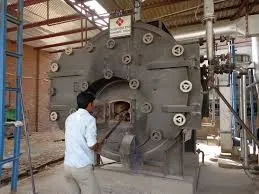
Eki . 18, 2024 13:11 Back to list
Overview of Industrial Steam Boiler Systems and Their Applications in Various Industries
Understanding Industrial Steam Boiler Systems
Industrial steam boiler systems are essential components in a variety of manufacturing processes, providing heat and power through steam generation. These systems are pivotal in industries such as food processing, chemical manufacturing, textiles, and energy production. This article aims to explore the fundamental aspects of industrial steam boiler systems, their components, operating principles, advantages, challenges, and future trends.
Components of Industrial Steam Boiler Systems
An industrial steam boiler system comprises several vital components that work together to generate steam efficiently. The primary components include the boiler itself, fuel supply system, feedwater systems, steam distribution network, and control systems.
1. Boiler The boiler is the heart of the steam-generating system. It is designed to convert water into steam through the application of heat. Boilers come in various types, including fire-tube, water-tube, and electric boilers, each suited for different applications.
2. Fuel Supply System Depending on the type of boiler, various fuels can be utilized, including natural gas, oil, coal, or biomass. The fuel supply system ensures a continuous and reliable supply of fuel for combustion processes.
3. Feedwater System Water is a critical component in the steam generation process. The feedwater system ensures that the boiler receives treated water at the required temperature and pressure. Proper treatment can prevent scale buildup and corrosion, extending the lifespan of the boiler.
4. Steam Distribution Network Once steam is generated, it needs to be distributed to different parts of the facility. The steam distribution network comprises pipes, valves, and fittings that transport steam to various applications, such as heating, power generation, and cleaning processes.
5. Control Systems Automation and control systems play a crucial role in ensuring the safe and efficient operation of steam boiler systems. These systems monitor pressure, temperature, and water levels, enabling operators to make adjustments as necessary.
Operating Principles
The operation of an industrial steam boiler system is based on two fundamental principles the generation of steam through heat transfer and the management of pressure. The boiler burns fuel to produce heat, which is transferred to water within the boiler. As the water absorbs heat, it transitions into steam. The pressure of the steam is carefully controlled to ensure it meets the requirements of the specific industrial process it serves.
Advantages of Industrial Steam Boiler Systems
Industrial steam boiler systems offer several advantages that make them indispensable in many sectors
industrial steam boiler system

2. Versatility Steam can be used for various applications, including heating, sterilization, and power generation, making these systems versatile across different industries.
3. Reliability Steam boiler systems are robust and can provide continuous operation, ensuring that industrial processes run smoothly without interruptions.
4. Scalability Industrial steam boiler systems can be scaled up or down according to the production needs of a facility, enabling tailored solutions for varying workloads.
Challenges in Industrial Steam Boiler Systems
Despite their advantages, industrial steam boiler systems also face several challenges
1. Maintenance Regular maintenance is essential to prevent breakdowns and ensure safety. Neglecting maintenance can lead to costly repairs and operational downtime.
2. Environmental Regulations Compliance with stringent environmental regulations regarding emissions can present challenges for steam boiler operators, leading to increased operational costs.
3. Water Quality The quality of feedwater plays a critical role in the efficiency and longevity of the boiler. Poor water quality can lead to scaling and corrosion, impacting performance.
Future Trends
The future of industrial steam boiler systems is likely to be influenced by advancements in technology and sustainability initiatives. Innovations such as improved combustion technologies, waste heat recovery systems, and the integration of renewable energy sources can enhance the efficiency and environmental performance of steam boiler systems.
Moreover, the adoption of smart technologies and the Internet of Things (IoT) can enable real-time monitoring and predictive maintenance, reducing downtime and increasing operational efficiency.
Conclusion
In conclusion, industrial steam boiler systems are essential to many manufacturing processes, providing versatile and reliable solutions for heat and power generation. Understanding their components, operating principles, advantages, and challenges is crucial for optimizing their performance. As industries continue to evolve, adopting new technologies and sustainable practices will ensure that steam boiler systems remain a vital component of industrial operations in the future.
-
Best Steam Boiler Design PDF Free Design Calculation & Diagram Downloads
NewsJun.10,2025
-
Hot Boiler Water Heater Efficient Heating Solutions for Home & Commercial Use
NewsJun.10,2025
-
Steam Boiler Safety Devices High-Quality Protection Valves
NewsJun.10,2025
-
Ultimate Steam Boiler Checklist for Safety & Efficiency
NewsJun.10,2025
-
Optimal Hot Water Boiler Temperature Setting Guide
NewsJun.10,2025
-
Effective Hot Water Boiler Chemical Treatment Protect & Maintain
NewsJun.09,2025
Related PRODUCTS






















